Finding the best microphones under $500 opens up a world of professional-quality recording without the crushing expense of flagship studio gear. After I reviewed dozens of microphones in this price range over the past few years, I’ve learned that this sweet spot offers exceptional value you’re getting mics that genuinely compete with equipment costing twice as much, but you’re not paying for the boutique branding or that last 5% of performance that only matters in world-class facilities. The reality is that most home studios, content creators, and even professional engineers working on location will find everything they need within this budget range.
| Microphone Model | Key Features | Pros | Cons |
|---|---|---|---|
| Shure SM7B | Dynamic mic with smooth, warm tone; built-in pop filter; presence boost and bass rolloff switches; exceptional noise rejection. | – Legendary build and reliability- Excellent for vocals, podcasting, and instruments- Superb noise rejection for untreated rooms- Warm, natural tone- Built-in pop filter reduces plosives- Strong resale value | – Needs high clean gain (60+ dB)- Not ideal for bright, detailed sources- Heavy, requires sturdy stand- Cost increases with gain booster |
| Audio-Technica AT4050 | Large-diaphragm condenser with 3 switchable polar patterns (cardioid, omni, figure-8); handles high SPL; low self-noise. | – Multi-pattern flexibility- Balanced, transparent sound- Excellent build quality- Works on loud and quiet sources- Includes quality shock mount | – Captures room reflections easily- Near $500 price point- Sensitive to stand vibrations- Requires phantom power |
| Rode NT1 | Large-diaphragm condenser with ultra-low self-noise (4.5 dB); bright, detailed tone; full recording bundle included. | – Extremely quiet operation- Complete package (shock mount, pop filter, cable)- Bright, flattering sound for vocals- Professional results at low cost- Excellent build and reliability | – Bright tone may emphasize sibilance- Single cardioid pattern- Sensitive to room acoustics- Some find it too neutral |
| Aston Origin | Cardioid condenser with integrated shock mount; warm, vintage-inspired tone; stainless steel chassis. | – Built-in shock mount reduces clutter- Smooth, warm sound- Rugged stainless steel design- Minimal EQ needed- Excellent off-axis rejection- Includes quality case | – Less isolation than premium mounts- Warm tone may lack transparency- Single pattern only- Unique look not for everyone |
| Lewitt LCT 440 PURE | Cardioid condenser with advanced internal suspension; clear, forward sound; includes magnetic pop filter and pro shock mount. | – Very low handling noise- Clear, present vocal tone- High SPL handling (140 dB)- Excellent included accessories- Consistent off-axis response- Great modern design | – Less “vintage warmth”- Lower resale recognition- Magnetic pop filter limited for strong plosives- Single polar pattern |
Shure SM7B: The Broadcasting Legend That Does Everything
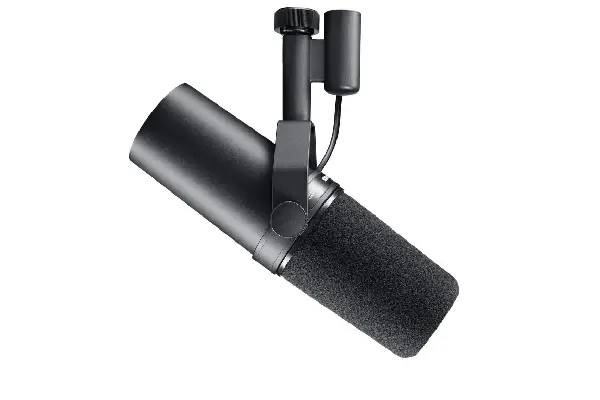
The Shure SM7B has become something of a cultural icon in the recording world, and after spending months with this microphone across multiple projects, I completely understand why.The SM7B uses a dynamic capsule design, which means it’s less sensitive than condenser microphones and requires a good amount of clean gain to perform optimally.
What makes the SM7B special is its remarkable versatility combined with its natural rejection of room noise and background ambiance. The built-in pop filter works exceptionally well I rarely need an external pop screen when recording vocals, which streamlines my setup considerably. The microphone comes with both presence boost and bass rolloff switches on the back, and I found myself using the presence boost frequently for adding clarity to spoken word content without introducing harshness.
The SM7B’s sound signature is warm and intimate without being muddy, and it handles plosives better than almost any microphone. One thing I particularly appreciate is how forgiving it is with untreated rooms because it’s a dynamic mic with a relatively tight polar pattern, it doesn’t pick up nearly as much room reflection as large-diaphragm condensers. This makes it an outstanding choice for home studios where acoustic treatment might be limited. I’ve recorded in less-than-ideal spaces where condenser mics would have captured every echo and HVAC rumble, but the SM7B stayed focused on the source.
However, there’s an important caveat: this microphone demands substantial clean gain. After adding a Cloudlifter inline preamp (an additional investment), the SM7B truly came alive. If you’re considering this microphone, factor in whether your current interface can provide 60+ dB of clean gain, or budget for an inline preamp or Fethead. Despite this requirement, the SM7B remains one of the most reliable, professional-sounding microphones you can buy under $500, and its resale value holds remarkably well if you ever decide to upgrade.
Pros:
- Exceptional build quality with legendary Shure durability that will last decades
- Remarkably versatile across vocal recording, broadcasting, podcasting, and instrument applications
- Outstanding background noise rejection makes it forgiving in untreated spaces
- Warm, smooth frequency response that flatters most voices without sounding artificially colored
- Built-in pop filter eliminates need for external screens in most applications
- Strong resale value and widespread professional acceptance in the industry
Cons:
- Requires significant clean gain (60+ dB), often necessitating an additional preamp like a Cloudlifter
- Not ideal for capturing detailed transients or extremely bright sources due to dynamic design
- Heavier than most mics, requiring a sturdy boom arm or mic stand
- At this price point, it’s a significant investment if you need to factor in gain accessories
Audio-Technica AT4050: The Studio Workhorse That Punches Above Its Weight
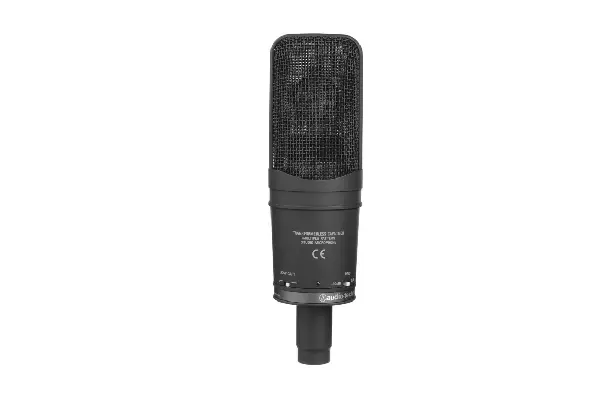
After I reviewed the Audio-Technica AT4050, it immediately became one of my most-reached-for microphones in the studio, and I now understand why so many professional facilities keep several of these on hand. This large-diaphragm condenser offers three switchable polar patterns cardioid, omnidirectional, and figure-8 which gives it remarkable flexibility for different recording scenarios. The build quality is outstanding, with a hefty brass body that feels premium in your hands, and the included shock mount is actually usable (unlike some manufacturers who include flimsy mounts that belong in the trash).
What impressed me most about the AT4050 is its remarkably balanced frequency response. The microphone handles high sound pressure levels beautifully , and the self-noise is low enough for quiet sources like fingerstyle acoustic guitar.The three polar pattern options expand the microphone’s utility considerably.
One consideration is that being a large-diaphragm condenser, the AT4050 will reveal room acoustics more than dynamic microphones. If you’re working in an untreated bedroom studio, you’ll want at least some basic acoustic panels to prevent excessive room reflection from being captured. I also found that the microphone is somewhat sensitive to handling noise through the stand, so a quality shock mount (the included one works well) is essential. The AT4050 requires phantom power, of course, which any decent audio interface provides. When comparing recorded music quality across different microphone options, the transparency and accuracy of the AT4050 consistently deliver professional results that translate well in mixes.
Pros:
- Three switchable polar patterns dramatically expand recording possibilities and techniques
- Exceptionally balanced, transparent frequency response that works across virtually any source
- Outstanding build quality with brass construction that feels and performs like more expensive mics
- Handles high SPL without distortion, making it suitable for loud sources
- Low self-noise allows for quiet source recording without excessive background hiss
- Included shock mount is actually functional and well-designed
Cons:
- As a large-diaphragm condenser, it reveals room acoustics and requires decent acoustic treatment
- More expensive than some options on this list, sitting near the $500 ceiling
- Sensitive to mechanical vibration and handling noise through microphone stands
- Requires phantom power, which eliminates some portable recording scenarios
Rode NT1: The Best Value in Large-Diaphragm Condensers
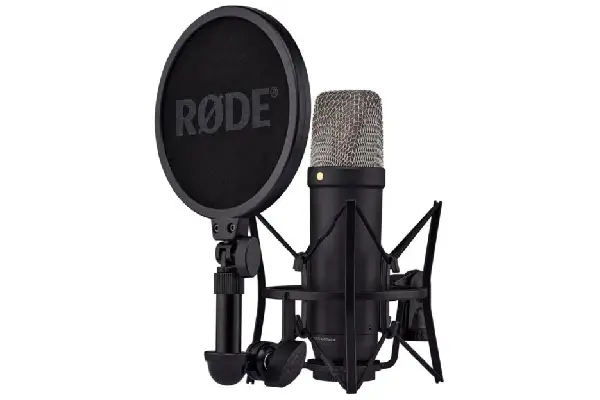
The Rode NT1 has earned its reputation as perhaps the best value proposition in studio microphones, and after spending considerable time with this mic across various projects, I can confidently say that reputation is well-deserved. When I first tested the NT1, I was genuinely shocked by how quiet it isRode claims it as one of the world’s quietest studio microphones with only 4.5dB of self-noise, and in practical use, this means you can record even whisper-quiet sources without worrying about background hiss creeping into your recordings. The current version of the NT1 comes in a complete package with a shock mount, pop filter, and cable, which represents exceptional value considering the microphone alone would be worth the asking price.
What makes the NT1 special is its bright, detailed character that seems to flatter vocals particularly well. This makes it especially popular for pop, singer-songwriter, and contemporary vocal styles where clarity and detail matter. I’ve recorded entire EPs using the NT1 as the primary vocal microphone, and the results have been consistently impressive professional-sounding recordings that compete with tracks captured on microphones costing several times as much.
The microphone’s construction is solid, with Rode’s typically excellent build quality evident in every aspect. The included SM6 shock mount is a standout feature it’s a professional-grade suspension system that genuinely isolates the microphone from stand vibrations and handling noise. The integrated pop filter works well for controlling plosives, though I sometimes prefer using an external pop screen for additional protection when working with singers who have particularly explosive consonants. The NT1’s cardioid polar pattern provides good side and rear rejection, which helps in minimizing room reflections and focusing on the intended source.
One thing to note is that the NT1’s bright character, while generally flattering, might not suit every voice or application. When I tested it with particularly sibilant vocalists, the high-frequency emphasis sometimes required careful de-essing in post-production. Similarly, on very bright acoustic guitar recordings, I found myself cutting a bit of top-end to prevent the sound from becoming too thin or aggressive. However, these are minor considerations in the context of what you’re getting for the price. For home studio owners who primarily record vocals and acoustic instruments, the NT1 represents exceptional value. If you’re interested in expanding your studio setup beyond microphones, exploring different instruments can provide creative inspiration for your recordings.
Pros:
- Extraordinarily low self-noise (4.5dB) allows for recording the quietest sources without noise issues
- Excellent complete package including professional shock mount, pop filter, and cable
- Bright, flattering frequency response that works particularly well for contemporary vocal styles
- Outstanding value proposition professional results at a fraction of typical studio mic costs
- Solid build quality with Rode’s reputation for reliability and durability
- Forgiving of less-than-perfect recording technique while still capturing detail
Cons:
- Bright character might require EQ adjustment with sibilant vocalists or very bright sources
- Single cardioid pattern limits versatility compared to multi-pattern microphones
- As a large-diaphragm condenser, still requires reasonably controlled acoustic environment
- Some users find it less characterful or “boring” compared to mics with stronger sonic signatures
Aston Origin: British Character with Innovative Design
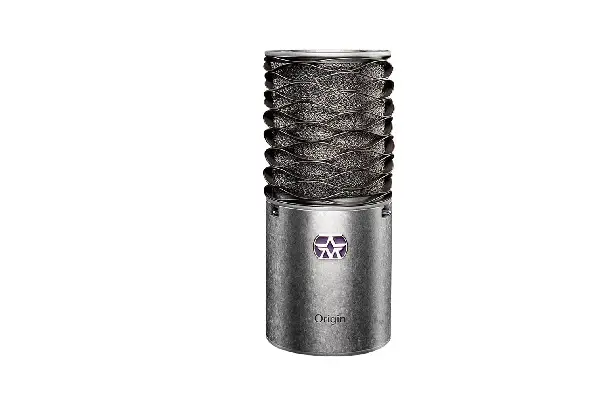
The Aston Origin caught my attention initially because of its distinctive appearance the tumbled stainless steel finish and integrated shock mount give it a futuristic look that stands out from traditional microphones. But after I reviewed the Origin extensively, I discovered that this isn’t just style over substance; Aston has created a genuinely impressive microphone with thoughtful engineering throughout. The integrated shock mount, called the “Aston hinge,” is a brilliant design that eliminates the need for external suspension while effectively isolating the capsule from vibration. In my experience, this works remarkably well, and I appreciate having one less piece of hardware cluttering my mic cabinet.
What makes the Origin sonically interesting is its slightly warm, vintage-inspired character with a gentle presence peak that adds clarity without harshness. The microphone uses a 1-inch capsule with a cardioid pattern, and the off-axis rejection is excellent I’ve recorded in rooms with parallel walls where other microphones picked up distracting reflections, but the Origin stayed remarkably focused on the source. The frequency response has been optimized to minimize the need for corrective EQ, and I’ve found this to be true in practice; recordings often sound finished with minimal processing.
The build quality is exceptional, with that tumbled stainless steel chassis providing both durability and effective shielding against electromagnetic interference. At 450 grams, it’s substantial without being unwieldy, and the integrated mount means there are fewer connection points where rattles or vibrations could develop over time. Aston includes a swivel stand adapter that works with standard mic stands, and I appreciate how the design allows you to position the microphone at any angle without complicated adjustment mechanisms. The Origin ships in a quality padded case, which is a nice touch that some manufacturers skip at this price point.
Pros:
- Innovative integrated shock mount eliminates need for separate suspension hardware
- Distinctive warm vintage character that flatters vocals and acoustic instruments beautifully
- Exceptional build quality with durable stainless steel chassis and professional feel
- Optimized frequency response typically requires minimal corrective EQ in mixing
- Excellent off-axis rejection helps minimize room reflections and background noise
- Includes quality case and accessories that enhance the overall value proposition
Cons:
- Integrated mount, while convenient, offers slightly less isolation than premium external shock mounts
- Warmer character might not suit applications requiring ultimate transparency or analytical accuracy
- Single cardioid pattern limits flexibility compared to multi-pattern alternatives
- Distinctive appearance might not appeal to those preferring traditional microphone aesthetics
Lewitt LCT 440 PURE: Modern Innovation at an Accessible Price
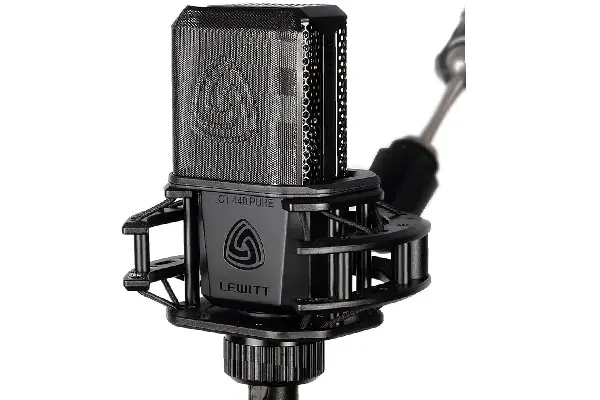
The Lewitt LCT 440 PURE represents the new generation of microphone design, and after I reviewed several Lewitt microphones, I’ve become impressed with how this Austrian company approaches engineering challenges with fresh thinking. When I tested the LCT 440 PURE, what immediately stood out was its remarkably low handling noise and vibration sensitivity Lewitt has clearly invested significant engineering effort in capsule suspension and internal shock mounting. This makes it forgiving in real-world studio situations where you might bump the stand or adjust positioning during a session.
What makes the LCT 440 PURE interesting sonically is its slightly forward character with excellent presence and clarity that helps sources cut through dense mixes. In my experience recording vocals, this microphone adds a subtle emphasis in the 3-6 kHz range that enhances intelligibility and presence without sounding harsh or aggressive. I’ve used it successfully across various vocal styles, and it particularly excels with contemporary pop, rock, and hip-hop where vocal clarity and detail are paramount. The microphone features a cardioid polar pattern with unusually consistent performance across its frequency range off-axis coloration is minimal, which means recordings maintain their tonal character even when the singer moves slightly off-axis.
The build quality is excellent, with Lewitt’s attention to detail evident throughout. The microphone comes with an outstanding shock mount that genuinely isolates vibration, a magnetic pop filter that attaches directly to the mic body (a clever innovation), and a quality carrying case. The shock mount uses an innovative clamp design that makes mounting and removing the microphone quick and secure, which I appreciate during sessions when I’m swapping mics for different sources. The magnetic pop filter is surprisingly effective it provides good plosive control without the fiddly positioning typical of traditional pop screens, though I sometimes still prefer an external screen for extra protection with particularly explosive singers.
Pros:
- Exceptionally low handling noise and vibration sensitivity due to advanced internal mounting
- Forward, clear character that helps vocals cut through mixes with excellent presence and detail
- Outstanding included accessories including innovative magnetic pop filter and professional shock mount
- High SPL handling (140 dB) makes it versatile beyond vocal recording applications
- Consistent off-axis performance maintains tonal character with slight microphone positioning changes
- Modern build quality with thoughtful engineering throughout the design
Cons:
- Forward character, while often flattering, might not suit applications requiring warm vintage sound
- Less well-known brand compared to industry standards, which might affect resale value
- Magnetic pop filter, while innovative, may not provide enough protection for extremely explosive vocalists
- Single polar pattern limits versatility compared to switchable pattern alternatives
Frequently Asked Questions
What’s the most important factor when choosing a microphone under $500?
The most important factor is matching the microphone type and character to your specific application and recording environment. In my experience, dynamic microphones like the Shure SM7B work better in untreated rooms because they reject background noise naturally, while large-diaphragm condensers offer more detail but require decent acoustic treatment to sound their best. Consider what you’ll primarily record—vocals, instruments, podcasts and whether your space has acoustic challenges before choosing between dynamic and condenser designs.
Do I need an expensive preamp to get good results from these microphones?
It depends on the specific microphone. When I tested the Shure SM7B with an entry-level audio interface, the results were disappointing until I added a Cloudlifter inline preamp to provide adequate clean gain. However, the condenser microphones on this list the AT4050, Rode NT1, Aston Origin, and Lewitt LCT 440 PURE—all work excellently with the built-in preamps found in quality audio interfaces like Focusrite Scarlett, Universal Audio Volt, or MOTU M-series units. Modern interfaces generally provide clean phantom power and sufficient gain for condenser mics without requiring external preamps.
Can these microphones be used for live performance or are they studio-only?
The Shure SM7B is occasionally used in live broadcasting situations, though it’s primarily a studio microphone requiring phantom power or external gain. The condenser microphones (AT4050, Rode NT1, Aston Origin, Lewitt LCT 440 PURE) are all studio microphones they’re too sensitive and fragile for typical live sound reinforcement applications. For live performance, you’d want to consider dynamic stage microphones designed to handle physical abuse and feedback rejection, which is a different category entirely from these studio recording microphones.
How much difference does room acoustics make with these microphones?
Room acoustics make a dramatic difference, particularly with large-diaphragm condenser microphones. When I tested the AT4050 and Rode NT1 in my untreated bedroom versus a space with basic acoustic panels, the difference was night and day reflections, flutter echo, and room resonances that were glaringly obvious in the untreated space essentially disappeared with even modest treatment. The Shure SM7B is the most forgiving option here because its dynamic design and tight polar pattern naturally reject room sound, making it the best choice if acoustic treatment isn’t feasible in your space.
Are these microphones good investments that hold their value?
Generally yes, particularly the Shure SM7B and Audio-Technica AT4050, which are industry standards with strong used markets. In my experience tracking used gear prices, the SM7B retains exceptional resale value—you can often sell a well-maintained unit for 70-80% of what you paid, sometimes more if you include accessories. The Rode NT1, Aston Origin, and Lewitt LCT 440 PURE depreciate more typically but still hold reasonable value as quality tools. These are all professional-grade microphones that will last decades with proper care, making them sound investments whether you keep them long-term or eventually upgrade.

